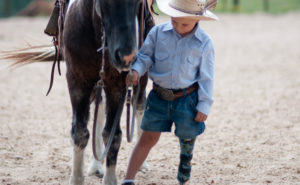When a child needs a prosthetic, it involves much more than simply replacing a limb. It’s about providing them with the means to explore, play, and develop with confidence. Pediatric prosthetics are not one-size-fits-all; they are designed to meet specific needs, ranging from sports activities to everyday use. Various types of pediatric prosthetics are created to enhance mobility, comfort, and independence in children.
Key Takeaways:
- Types of Pediatric Prosthetics: Transradial (below the elbow), Transhumeral (above the elbow), Transtibial (below the knee), Transfemoral (above the knee). Upper-limb devices prioritize grip; lower-limb devices prioritize weight-bearing and movement.
- Accommodating Growth: Adjustable/modular designs with interchangeable parts allow resizing as kids grow. Prosthetics are often resized yearly.
- Materials & Technology: Made with lightweight, durable materials (e.g., carbon fiber, titanium, silicone). Innovations include 3D printing, bionic prosthetics, and sensor technology for natural movements.
- Tailored Functionality: Activity-specific prosthetics (e.g., swimming, running) help kids enjoy hobbies/sports. Comfort and adjustability ensure a natural fit.
- Rehabilitation: Involves prosthetists, therapists, and psychological support. Gait training and physical therapy improve movement and confidence.
- Parental Support: Regular check-ups, skin monitoring, and encouraging participation in activities boost confidence.
- Costs & Funding: Costs range from $5,000-$50,000+; non-profits and grants (e.g., Amputee Coalition) help families manage expenses.
What are the different types of pediatric prosthetics?
Pediatric prosthetics come in four main types: transradial, transhumeral, transtibial, and transfemoral. Each type matches the part of the body where the prosthetic is needed.
Transradial prosthetics replace the arm below the elbow. These are for kids who have lost part of their lower arm. The prosthetic attaches just below the elbow and can include functional hands to help with gripping.
Transhumeral prosthetics replace the arm above the elbow. These are necessary when the upper arm and elbow are missing. Since these go higher, they often include added joints for bending and movement.
Transtibial prosthetics replace the leg below the knee. These are common for children whose lower legs are missing. The knee joint stays intact, so movement with these prosthetics can feel more natural.
Transfemoral prosthetics replace the leg above the knee. These devices are for children whose thigh and knee are missing. They often include mechanical or computerized knee joints for mobility.
Upper-limb prosthetics, like transradial and transhumeral, focus on precision and grip. Lower-limb prosthetics, like transtibial and transfemoral, concentrate on weight bearing and movement. Kids need designs that are durable and lightweight because they are active and still growing.
Custom design and adjustability are key. Growth can change how a prosthetic fits, and a poorly fitting prosthetic can cause discomfort. Specialized clinics, like Horton’s Orthotics & Prosthetics, create solutions tailored to each child. These designs also come in fun patterns or colors to make them kid-friendly.
For extra information, check resources like the Amputee Coalition. They provide details for families navigating the world of pediatric prosthetics.

How do pediatric prosthetics accommodate a child's growth?
Different types of pediatric prosthetics are designed to grow with the child. Adjustable and modular features play a key role in this. These designs make it easier to modify or resize the device as the child gets taller or gains weight. For example, some prosthetics have interchangeable parts or extendable limbs. This reduces the need for frequent full replacements, saving time and money while keeping the fit comfortable.
Pediatric prosthetics often need resizing or replacement at least once a year. Children grow quickly, especially during their first years. Growth spurts can lead to a prosthetic no longer fitting properly. Regular check-ups help track these changes. Prosthetists adjust the device or replace parts to maintain functionality and comfort for the child.
One of the biggest challenges in accommodating growth is balancing durability with flexibility. Prosthetics for children need to withstand daily wear and tear while still being light and adaptable. Sudden growth can create pressure points or uneven weight distribution, making the prosthetic uncomfortable. Close communication with a prosthetist can address these issues early.
For more detail on this topic, you can explore this guide on understanding your child’s prosthetic and their growth. It explains how growth impacts prosthetics and ways parents can stay proactive.
Learning to adjust to prosthetics is easier with tools, resources, and patience. If you're looking for tips to help your child adapt, this resource on helping your child adjust to their prosthesis is a practical place to start.
What materials and technologies are used in pediatric prosthetics?
Pediatric prosthetics rely on materials that make them lightweight yet durable. Most devices use carbon fiber, titanium, or advanced plastics. These materials resist wear and tear while staying light enough for children to move freely. Silicone is also popular because it feels soft against the skin and avoids irritation.
One exciting advancement is the use of 3D printing in pediatric prosthetics. With 3D printing, prosthetics can be customized quickly and affordably. This technology allows each device to fit a child's specific shape and size. It’s also great for creating colorful designs that kids love, making wearing the prosthetic less stressful.
Another major breakthrough is the development of bionic prosthetics. Bionic devices include sensors that read muscle signals. These sensors send data to small motors in the prosthetic. This allows smoother movement, almost like a natural limb. For example, a child with a bionic hand can grip a cup or write with a pencil.
Sensors also add smart features to prosthetics. Some sensors detect pressure, making adjustments to ensure comfort during long use. Others sync with apps, helping parents track usage and alerting them to possible problems. With these technologies, prosthetics are becoming more than tools—they are part of a child's daily life.
To care for a prosthetic properly, parents can explore helpful resources like teaching your child how to care for a prosthetic limb. Additionally, on the research side, institutions like Lurie Children's continue to unlock ways to make prosthetics even better for kids.
How are pediatric prosthetics tailored for functionality and activities?
Pediatric prosthetics go beyond just restoring movement—they help kids live fully. Activity-specific prosthetics are an exciting example of this. For instance, there are prosthetics designed specifically for swimming, running, or even dancing. Each one is made to match the needs of that activity. Running prosthetics, for example, have a curved blade design to help with speed and balance. Swim prosthetics are made to resist water and improve buoyancy. These designs help children enjoy hobbies and sports with friends.
Comfort and adaptability are key for everyday use as well. Prosthetic fittings focus on ensuring the device feels natural and doesn’t cause pain. A comfortable prosthetic is more likely to be worn consistently, which helps children feel included in both daily tasks and fun activities. Adjustability matters because kids grow quickly. Flexible designs ensure the prosthetic can change as they grow, meaning fewer replacements are needed.
Functionality also boosts a child’s self-confidence and social inclusion. A well-made prosthetic can let children perform tasks or sports without limitation. Imagine a child joining a soccer game with ease or dancing without hesitation. Tailored designs like these help kids feel capable and connected to others. You can learn more about helping children adjust on this helpful guide. Plus, groups like the Challenged Athletes Foundation and ABLE provide resources and events to inspire active lifestyles.
With these innovations, pediatric prosthetics have become much more than medical devices. They are tools to help kids build confidence, stay active, and grow stronger.
What is the rehabilitation process like for child amputees using prosthetics?
Rehabilitation for children with prosthetics is not just about movement—it's about teamwork. A dedicated care team, including prosthetists, physical therapists, and doctors, works together. Each expert has a specific role to help the child succeed. Prosthetists ensure the prosthetic fits well and adjusts as the child grows. Therapists design exercises that teach safe walking and running with pediatric prosthetics. Meanwhile, doctors monitor the child's overall health and track progress.
Gait training is an essential step. Children learn how to walk, stand, and balance with their new prosthetic. Therapists often break this process into small, manageable tasks, building confidence one step at a time. Many children also undergo physical therapy to strengthen their muscles and improve coordination. For activities like running with pediatric prosthetics, specialized exercises help develop speed and precision.
The emotional side of rehabilitation is just as important. Child amputees might face feelings of frustration, sadness, or anxiety as they adapt. Psychological support teaches coping strategies, helping children develop resilience. Support groups for both kids and parents offer a chance to share experiences and find encouragement.
Recovery and adaptation may feel challenging, but with the right team and tools, children can achieve incredible milestones. External resources, like Arm Dynamics, specialize in pediatric prosthetics and provide a wealth of support. They give families the guidance needed to navigate this life-changing journey.
How can parents and caregivers support children using prosthetics?
Parents play a big role when a child uses a prosthetic. Regular check-ups keep the prosthetic working well. These visits find problems early and ensure a good fit as your child grows. You should also check their skin often. Look for redness or sores where the prosthetic touches, as these could mean a poor fit.
Helping your child build confidence is one of the best supports. Encourage them to use their prosthetic in activities they love, like sports or dancing. Joining clubs or groups helps them meet others with prosthetics. Social support can boost self-esteem and show them they are not alone.
Financial resources can ease the cost of prosthetics. Organizations like Limbs for Life help families afford these devices. You can also find education resources to learn more about caring for prosthetics. This knowledge makes you and your child feel better prepared.
What are the cost considerations and funding options for pediatric prosthetics?
The cost of pediatric prosthetics can range from $5,000 to over $50,000. The price depends on factors like the type of prosthetic and its features. For example, a basic prosthetic might cost less than a bionic one with advanced technology. Since children grow, devices often need resizing or replacing, which adds to the cost.
Many families find health insurance for prosthetics challenging. Some plans partially cover the cost, while others may not include prosthetics at all. Even when covered, there are often restrictions. Parents must review their policies carefully to understand what is included.
Thankfully, non-profit organizations and funding programs can help families manage costs. Groups like the Amputee Coalition or the Challenged Athletes Foundation provide grants and support. These programs aim to make prosthetics more accessible for every child needing one. Families can explore federal funding options, too, though eligibility varies by location. Every bit of support can make a big difference in ensuring a child gets the prosthetic they need.
Pediatric prosthetics empower children by restoring movement and confidence. From custom designs to activity-focused features, these solutions adapt and grow with your child. Cutting-edge materials and technologies ensure durability, while adjustable designs accommodate physical changes over time. Rehabilitation and caregiver support are vital for successful use. Though costs can be significant, funding options exist to help families manage expenses. Every prosthetic represents more than a tool—it’s an opportunity for independence. Choosing the right prosthetic and support system lets your child thrive in every stage of life.
Helping Your Child Thrive: Pediatric Prosthetics Tailored for Growth and Independence
At Horton’s Orthotics and Prosthetics, we’re here to help your child take the first step toward independence and confidence. With customized care, types of pediatric prosthetics, and innovative solutions, we’ll ensure the perfect fit for their needs—because every child deserves the freedom to play, explore, and grow. Visit us today to learn more!



